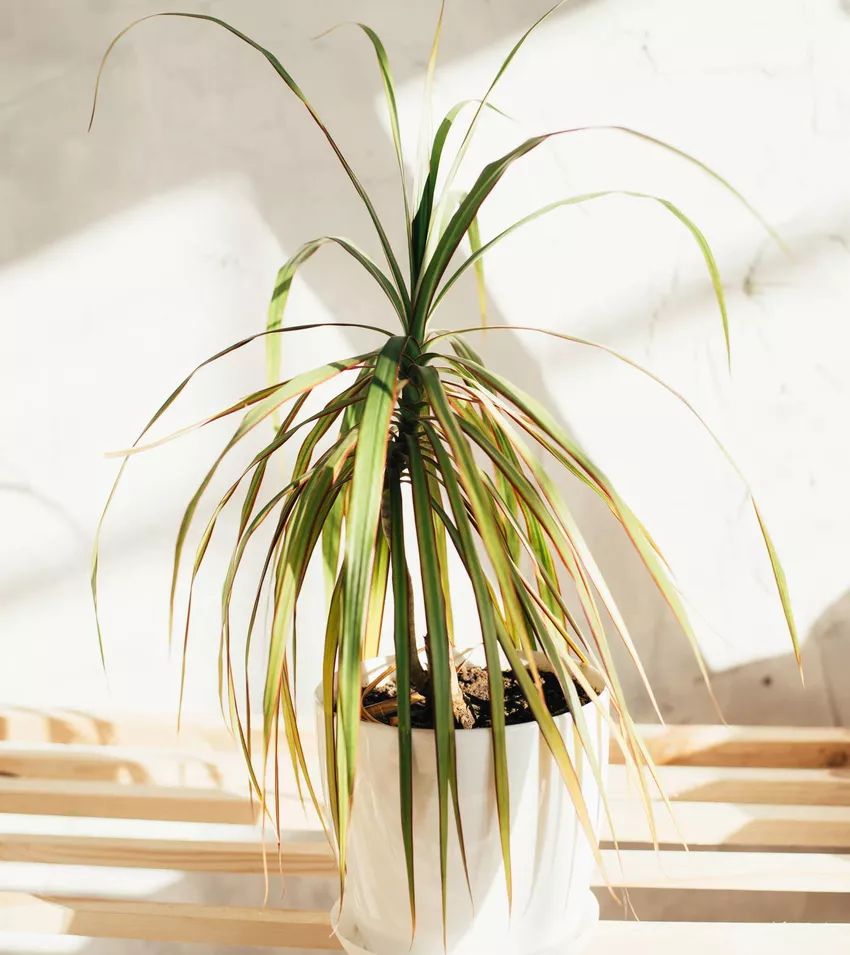A dragon tree can be a loyal companion as a houseplant for years. This loy alty should be rewarded with occasional repotting.
The dragon tree (Dracaena) is very frugal when it comes to the demands on its care. However, to ensure that you can enjoy your dragon tree over the long term - i.e. for many years - you should repot it at regular intervals. We explain how it works in 8 steps.
Repot dragon tree: why?
The dragon tree is often sold in the root ball, whereby the plant substrate often has a high peat content. Due to the grain size spectrum, the plant substrate tends to sag and compact when watered regularly. The permeability of the earth suffers greatly as a result and the availability of oxygen plummets. However, the dragon tree is an oxygen-loving plant, which is why the deficiency can seriously affect it. Repotting also means loosening up or replacing the substrate, which can give your dragon tree new vitality. Therefore, when renewing the plant substrate, use something with a balanced grain size range, for example with a higher percentage of perlite.
Repotting the dragon tree: When is the right time?
The dragon tree shows its strongest growth in spring. Although in our latitude it can only grow in closed rooms, it is nevertheless influenced by the increased radiation intensity. The right time for regular repotting is before the increased growth in spring. Should pests, root rot or similar occur in the meantime, it is of course advisable to repot the dragon tree at any time.

Repotting Dragon Tree Instructions
Repotting your Dracaena is not absolutely necessary, but it can give your dragon tree new vitality. If you do not repot for too long, it can lead to reduced growth and wilted leaves. The regular best time to repot your dragon tree is generally before the peak growth period in spring. After repotting, theRoots then unfold in the fresh and permeable substrate and fully fill the new habitat.
Repot Dragon Tree": Choosing a Suitable Substrate for Repotting
The substrates in which the dragon tree is usually sold are often characterized by a high percentage of peat. Due to its high proportion of organic material, peat tends to sink and compact with regular watering. By mixing in volcanic rock granules or similar draining substrates when repotting, you can increase permeability and ensure better oxygen supply.

Prepare dragon tree for repotting
You can make it much easier for your dragon tree to get started in the new pot if you water the root ball vigorously again after removing the plant from the previous pot. You can also immerse the root ball in a bath for a short time so that the soil is completely saturated. By watering, you protect your dragon tree from being deprived of water by the new, possibly drier substrate.
Repot the dragon tree in a larger pot
It is important to meet the dragon tree's growth requirements. When choosing the new vessel, make sure that it is at least 2 to 3 centimeters larger in diameter than the old vessel. In order to ensure rapid growth in the new substrate, it is important to water the newly potted dragon tree sufficiently. The initially relatively dry substrate must be completely soaked so that the old root ball does not lose moisture directly.

Caring for the dragon tree after repotting
After repotting, the dragon tree needs little attention when it comes to caring for it. Once your darling has arrived in its new home and has established itself in the new planter, continue with the care as usual. During spring and early summer we advise regular fertilization. A liquid fertilizer such as our Plantura organic indoor and green plant fertilizer is very suitable. If an unsightly growth habit develops, you can restore the desired shape with a care cut. You can find detailed instructions and valuable tips for caring for your dragon tree and pruning your dragon tree in our special articles.
Find a suitable location for the dragon tree
The optimal lighting conditionsfor the dragon tree are entirely dependent on the color of its leaves. If your Dracaena has rather light leaves with more green parts, you should choose a semi-shady location to avoid radiation damage. If your dragon tree tends to be reddish in colour, there are more anthocyanins in the leaves, which protect against damage from radiation, which is why it also feels at home in full sun.

Here is a summary of the most important things about repotting the dragon tree:
- Water the dragon tree well before repotting
- Circumference of the new vessel should be at least 2 - 3 cm larger than the old one
- Mixing in volcanic rock granules increases permeability and ensures better air supply
- Water enough after repotting dragon tree
- Continue normally with care measures afterwards
Our tip: If you don't want to regularly repot, you can think about growing a dragon tree in hydroponics. Here, the dragon tree is cultivated in a substrate made of permeable volcanic rock to give it support. The nutrient supply is operated solely via the water enriched with nutrients. The advantage of this is that it has to be repotted much less frequently than when growing in a standard substrate.
In addition to repotting, there are other care measures that should be carried out regularly on the dragon tree. In this article you will find out exactly what you should consider when caring for dragon trees.